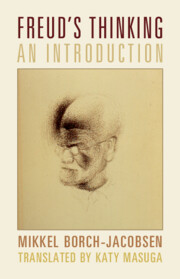Refine search
Actions for selected content:
77 results
Real Dehumanization
-
- Journal:
- Journal of the American Philosophical Association , First View
- Published online by Cambridge University Press:
- 24 November 2025, pp. 1-19
-
- Article
-
- You have access
- Open access
- HTML
- Export citation
10 - Violation, Mourning and Melancholia
- from Introduction to Part IV: Towards Abolition
-
- Book:
- Rethinking Criminal Justice
- Published online:
- 17 May 2025
- Print publication:
- 05 June 2025, pp 223-243
-
- Chapter
- Export citation
8 - Primitive and Mature Retributivism
- from Introduction to Part III: Synthesis and Atonement
-
- Book:
- Rethinking Criminal Justice
- Published online:
- 17 May 2025
- Print publication:
- 05 June 2025, pp 168-192
-
- Chapter
- Export citation
No Place for Robots: Reassessing the Bukimi no Tani (“Uncanny Valley”)
-
- Journal:
- Asia-Pacific Journal / Volume 18 / Issue 23 / December 2020
- Published online by Cambridge University Press:
- 14 March 2025, e4
-
- Article
-
- You have access
- Open access
- Export citation
4 - The Imaginary of the Modern Democratic Individual as a Political Agency
- from Part II - The Emergence of the Epistemological Constitution of Modern Democracy
-
- Book:
- Can Democracy Recover?
- Published online:
- 02 January 2025
- Print publication:
- 16 January 2025, pp 41-56
-
- Chapter
- Export citation
Chapter 5 - Love and Castration in G. V. Desani
-
- Book:
- Modernism and the Idea of India
- Published online:
- 02 January 2025
- Print publication:
- 09 January 2025, pp 112-135
-
- Chapter
- Export citation
Chapter 6 - Sophocles’ Oedipus Tyrannus
-
- Book:
- Choral Tragedy
- Published online:
- 25 April 2024
- Print publication:
- 02 May 2024, pp 135-159
-
- Chapter
- Export citation
Chapter 16 - Women, Gender, and Sexuality
- from Part III - Composition, Creation, and Reception
-
-
- Book:
- Leonard Bernstein in Context
- Published online:
- 06 April 2024
- Print publication:
- 28 March 2024, pp 131-139
-
- Chapter
- Export citation
Chapter 7 - The Totem and the Vampire
- from Part III - Societies of Blood
-
- Book:
- Biopolitics and Animal Species in Nineteenth-Century Literature and Science
- Published online:
- 11 January 2024
- Print publication:
- 01 February 2024, pp 150-179
-
- Chapter
- Export citation
Chapter 5 - Foreign Bodies
- from Part II - How Did Darwin Invent the Symptom?
-
- Book:
- Biopolitics and Animal Species in Nineteenth-Century Literature and Science
- Published online:
- 11 January 2024
- Print publication:
- 01 February 2024, pp 94-114
-
- Chapter
- Export citation
Chapter 1 - The Sphinx (Sphinx aenigmatica)
-
- Book:
- The Trojan Horse and Other Stories
- Published online:
- 09 November 2023
- Print publication:
- 11 January 2024, pp 13-32
-
- Chapter
- Export citation
Chapter 3 - Thinking the Pleasures with Psychoanalysis
-
- Book:
- The Pleasure of Thinking
- Published online:
- 05 October 2023
- Print publication:
- 19 October 2023, pp 94-126
-
- Chapter
- Export citation

Freud's Thinking
- An Introduction
-
- Published online:
- 21 September 2023
- Print publication:
- 05 October 2023
Chapter 19 - Franz Kafka
- from Part III - Themes and Influences
-
-
- Book:
- W. G. Sebald in Context
- Published online:
- 24 August 2023
- Print publication:
- 07 September 2023, pp 168-175
-
- Chapter
- Export citation
Chapter 1 - An Historical Overview of Psychodynamic Psychotherapy
- from Part 1: - An Overview of the Model
-
- Book:
- Cambridge Guide to Psychodynamic Psychotherapy
- Published online:
- 25 August 2023
- Print publication:
- 10 August 2023, pp 1-17
-
- Chapter
- Export citation
Political Theory and the Volunteer: Lessons from Kahn’s Ethnography of ‘Our Unhappy Politics’
-
- Journal:
- German Law Journal / Volume 24 / Issue 4 / May 2023
- Published online by Cambridge University Press:
- 26 June 2023, pp. 657-671
-
- Article
-
- You have access
- Open access
- HTML
- Export citation
3 - ‘A Question without an Answer’
-
- Book:
- J. M. Coetzee and the Limits of the Novel
- Published online:
- 08 June 2023
- Print publication:
- 22 June 2023, pp 57-81
-
- Chapter
- Export citation
2 - ‘The Congeries That I Bless with the Name of Evil’
-
- Book:
- J. M. Coetzee and the Limits of the Novel
- Published online:
- 08 June 2023
- Print publication:
- 22 June 2023, pp 32-56
-
- Chapter
- Export citation
Chapter 17 - Short Fiction, Language Learning, and Innocent Comedy
- from Part IV - Theories
-
-
- Book:
- The Cambridge Companion to the American Short Story
- Published online:
- 11 May 2023
- Print publication:
- 25 May 2023, pp 269-282
-
- Chapter
- Export citation
Chapter 9 - The Mother Figure in the Surrealist Novel
- from II - Transgression and Excess
-
-
- Book:
- A History of the Surrealist Novel
- Published online:
- 02 February 2023
- Print publication:
- 16 February 2023, pp 152-167
-
- Chapter
- Export citation
